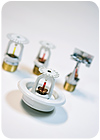
Fire sprinklers were developed and have been used effectively to protect property since the 1870s. So this is an old story-with a modern twist. Initially promoted by industrial insurance carriers who offered insurance savings for ‘highly protected risks,’ sprinklers earned their reputation for protecting properties against large fire losses. Along the way, another fact kept recurring-They Save Lives!
Those of us who daily spend most of our waking hours in a place of business give little thought to the dangers of fire. Why should we? Think about this National Fire Protection Association (NFPA) published fact: More than 80% of the fire deaths that occur annually do so in our places of residence! In other words, the places outside our homes-places in which we work, dine and take temporary quarters-are safer than our homes. One other fact is that a large percentage of fire deaths claim those who have the most difficulty fleeing: the young and the elderly, the two opposite ends of the age spectrum.
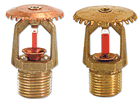
These photos illustrate the difference in bulb sizes of standard spray sprinklers-3 mm on the left and 5 mm on the right. All photos courtesy of Tyco Fire & Building Products.
The New Generation of Fire Sprinklers
In the early 1980s, spurred by the impressive life-saving record of automatic fire sprinklers, the industry began testing and developing a new generation of sprinklers that were intended to respond even more quickly in a fire condition. The efforts resulted in what are recognized as today’s ‘fast response’ sprinklers. Today’s fire sprinklers for residential and commercial applications operate more quickly in a fire condition, resulting in two advantages. One, water is delivered more quickly in a fire area; two, the occupants of the area gain time to safely exit the structure.The 1999 Edition of NFPA Pamphlet 13 defines thermal sensitivity of a fire sprinkler as “a measure of the rapidity with which the thermal element operates as installed in a specific sprinkler or sprinkler assembly.” The document goes further to define ‘fast response’ as a sprinkler having a thermal element with a response time index (RTI) of 50 (meters-seconds)1/2 or less. Standard response sprinklers have a thermal element having a response time index of 80 (meters-seconds)1/2 or more. RTIs were developed specifically as a measure of sprinkler sensitivity. Individual sprinkler RTIs are calculated by subjecting the sprinkler to a laminar airflow plunge test in a test oven. The RTI is a function of the following parameters:
- The actual operating time of the sprinkler being tested;
- The air temperature of the test oven;
- The air velocity within the test oven;
- A conductivity (or C) factor that is the measure of the conductance between the thermal element of the sprinkler and the oven mount of the sprinkler;
- The operating temperature of the thermal element, as determined by a bath test in which a sprinkler of the same type is operated.
- 3 mm bulb style sprinklers-35
- 5 mm bulb style sprinklers-95
- FR-1 & ESFR (solder link, fast response style)-26
Are all sprinklers installed today of the ‘fast response’ link style? No, there are occupancies (such as storage) in which the anticipated heat release is very high. In some of these types of occupancies, higher-temperature slower-acting sprinklers are actually desirable, as fewer sprinklers will open, and these are generally located directly above the fire area.
In the case of a residential setting, the fire load is actually very low, and the heat release is much smaller in a fire. Often, residential fires start in a small wastebasket or as a result of smoldering upholstery ignited by a cigarette. The heat release builds slowly, and the quicker-response sprinklers are more sensitive and function much more quickly.
What is the difference in the design between a standard response and a fast response sprinkler? The real magic is in the heat-sensitive thermal element of the sprinkler. For years, commercial and industrial fire sprinklers were huge brass-framed pieces of equipment that were unsightly. Between the sprinkler seat at the base of the sprinkler and the deflector that distributes the spray pattern was a solder link thermal element or a large glass bulb, often 5 to 11 mm in diameter.
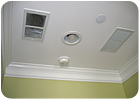
An installed flat-plate-concealed residential sprinkler surrounded by return air vents (left and right), a smoke detector (back) and a recessed light (middle). This photo shows how unobtrusive sprinklers can be compared to other items installed in a home.
In order to actuate, the entire mass of solder or liquid in a bulb had to reach the pre-set temperature at which the element would actuate. The trick to quicker operation was simple: Remove mass from the element to require less heat for actuation.
Using the principle of removing mass from the thermal element, thus requiring less time to reach the operating temperature, Grinnell developed the first fast response sprinkler in the early 1980s. The sprinkler featured a very thin nickel link, whose halves were soldered together. The sprinkler retained the same size and frame as a standard sprinkler at the time, but the response time was reduced significantly over those of standard sprinklers. The original nickel link design and several versions thereof are being used today in fast response sprinklers by several manufacturers.
Within a short time, glass bulb fire sprinklers that were considered standard response (having 5, 8 and 11 mm diameter glass ampoules) were tested and began appearing in the market with 3 mm glass bulbs. The thinner bulbs held less fluid; consequently, less mass to heat and quicker operation.
The NFPA codes make reference to quick response sprinklers. It is interesting to note that not all fast response sprinklers are considered quick response, but all quick response sprinklers do have fast response thermal elements. The reason: Some extended coverage sprinklers (often listed to 20 ft. x 20 ft. for commercial applications) have fast response links, but because of the large spacing, they actuate in a similar time to standard response sprinklers that are at smaller spacings.
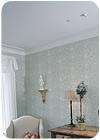
This sitting room contains a residential concealed flat plate installed (left) and a recessed light (right).
Benefits for Everyone
So, what does all of this mean for those of us over the age of 50? Well, it should mean the same thing to everyone, regardless of age. Since the introduction of the fast response thermal element, sprinkler manufacturers have been working to innovate new and less obtrusive designs that are aesthetically pleasing and blend into nearly any décor.Sprinklers can commonly be found in all types of residential occupancies-from hotels and motels, to apartments, condominiums and single-family homes.Proposed legislation has been introduced in Congress that would require automatic fire sprinkler protection in all Medicaid and Medicare facilities.
Individual states have passed requirements for senior citizen homes and nursing facilities to be fully equipped with working automatic fire sprinkler systems. More than 200 municipalities have adopted codes that mandate fire sprinklers in one- and two-family dwellings. Codes that have been enacted for multi-family apartments and condominiums have become the rule in most cities, rather than the exception.
Statistics confirm the effectiveness of fire sprinklers. The NFPA’s Fire Analysis and Research Division reports that for nursing homes, during the five-year period from 1994 through the end of 1998, an estimated average of 3,000 fires in facilities that care for the elderly were reported annually. The annual average was 12 deaths, 241 injuries, and $6.8 million in property damage. Nearly 75% of the facilities with reported fires in this period were protected with automatic fire sprinkler systems. The death rate in these facilities was one-sixth that of those without (data courtesy of NFPA, Nov/Dec 2003).
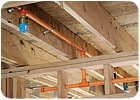
An unfinished house with sprinklers and CPVC installed. Notice the blue caps that are kept on two sprinklers during installation to protect the residential sprinkler system. After installation, these protective caps are removed and replaced with cover plates or escutcheons, depending on the sprinkler type.
Seniors aren’t limited to living in nursing and care facilities. Most have tried to stay in their own homes or move to smaller homes or apartments requiring less maintenance.The press regularly reports tragic deaths in residential fires, adding that the structure was or was not equipped with smoke detectors. But smoke detectors don’t afford any added time for egress from a burning structure-especially if the occupants have limited mobility.
Are fire sprinklers effective for residential applications? Look no farther than the 15-year report that was released by the city of Scottsdale, AZ. In 1986, Scottsdale was one of the first cities in the U.S. to enact a zero-tolerance code requiring fire sprinklers in all newly constructed residential dwellings. Fifteen years after the ordinance was enacted, Scottsdale had recorded only 13 deaths in unsprinklered homes (built prior to the ordinance) and zero deaths in homes that were protected.
The average loss (fire and water damage) per occurrence without sprinklers was $45,019, while homes with sprinkler systems averaged $2,166. Keep in mind that the Phoenix area is a haven for retirees and ‘snowbirds.’ Fellow seniors should take note: Your chances of surviving a fire in a newer home in Scottsdale are far better than in many other cities in the country.
How about the cost of residential fire sprinklers? New materials, such as CPVC pipe and fittings that are rated for use in light hazard and residential fire sprinkler systems have helped to make the systems more affordable than ever. PEX tubing has been approved for sprinkler systems in one- and two-family dwellings. Both materials are light, easy to install, and can be field measured and cut for installation in wood-joisted construction.
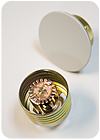
This photo is of a disassembled residential concealed flat plate sprinkler and its plate in order to show the working components of what is behind the flat plate. The sprinkler has three soldering points on its cap as its major thermal element.
In general, sprinklers can be provided for a cost that is less than a carpet upgrade in a home. Most homeowner policies also afford an annual credit of 5% to 15% for having sprinkler protection in the home. Some builders, such as Del Webb, now offer fire sprinklers as a ‘buyer option’ in their homes in retirement communities.
In closing, let’s go back to the premise of this piece-fast response sprinklers have been the key to bringing affordable fire protection to the very places in which we all live. For the record, and in anticipation of reader questions, yes, our home is protected by a residential fire sprinkler system. Wisdom comes with age. This is one way to prevent fire deaths that should be shared with our children.